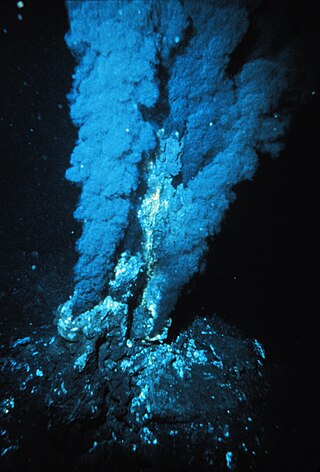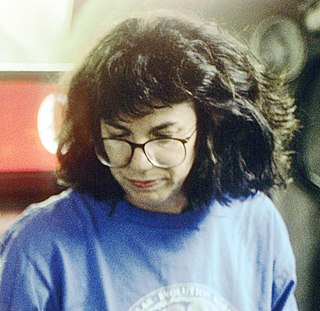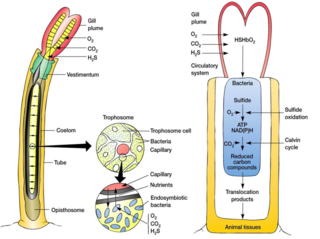
Siboglinidae is a family of polychaete annelid worms whose members made up the former phyla Pogonophora and Vestimentifera. The family is composed of around 100 species of vermiform creatures which live in thin tubes buried in sediment (Pogonophora) or in tubes attached to hard substratum (Vestimentifera) at ocean depths ranging from 100 to 10,000 m. They can also be found in association with hydrothermal vents, methane seeps, sunken plant material, and whale carcasses.

In biochemistry, chemosynthesis is the biological conversion of one or more carbon-containing molecules and nutrients into organic matter, organisms that obtain carbon from carbon dioxide through chemosynthesis, are phylogenetically diverse. Groups that include conspicuous or biogeochemically important taxa include the sulfur-oxidizing Gammaproteobacteria, the Campylobacterota, the Aquificota, the methanogenic archaea, and the neutrophilic iron-oxidizing bacteria.

Hydrothermal vents are fissures on the seabed from which geothermally heated water discharges. They are commonly found near volcanically active places, areas where tectonic plates are moving apart at mid-ocean ridges, ocean basins, and hotspots. Hydrothermal deposits are rocks and mineral ore deposits formed by the action of hydrothermal vents.

A cold seep is an area of the ocean floor where hydrogen sulfide, methane and other hydrocarbon-rich fluid seepage occurs, often in the form of a brine pool. Cold does not mean that the temperature of the seepage is lower than that of the surrounding sea water. On the contrary, its temperature is often slightly higher. The "cold" is relative to the very warm conditions of a hydrothermal vent. Cold seeps constitute a biome supporting several endemic species.

Riftia pachyptila, commonly known as the giant tube worm and less commonly known as the giant beardworm, is a marine invertebrate in the phylum Annelida related to tube worms commonly found in the intertidal and pelagic zones. R. pachyptila lives on the floor of the Pacific Ocean near hydrothermal vents. The vents provide a natural ambient temperature in their environment ranging from 2 to 30 °C, and this organism can tolerate extremely high hydrogen sulfide levels. These worms can reach a length of 3 m, and their tubular bodies have a diameter of 4 cm (1.6 in).

Gammaproteobacteria is a class of bacteria in the phylum Pseudomonadota. It contains about 250 genera, which makes it the most genus-rich taxon of the Prokaryotes. Several medically, ecologically, and scientifically important groups of bacteria belong to this class. It is composed by all Gram-negative microbes and is the most phylogenetically and physiologically diverse class of Proteobacteria.

Colleen Marie Cavanaugh is an American academic microbiologist best known for her studies of hydrothermal vent ecosystems. As of 2002, she is the Edward C. Jeffrey Professor of Biology in the Department of Organismic and Evolutionary Biology at Harvard University and is affiliated with the Marine Biological Laboratory and the Woods Hole Oceanographic Institution. Cavanaugh was the first to propose that the deep-sea giant tube worm, Riftia pachyptila, obtains its food from bacteria living within its cells, an insight which she had as a graduate student at Harvard. Significantly, she made the connection that these chemoautotrophic bacteria were able to play this role through their use of chemosynthesis, the biological oxidation of inorganic compounds to synthesize organic matter from very simple carbon-containing molecules, thus allowing organisms such as the bacteria to exist in deep ocean without sunlight.

Kagoshima Bay also known as Kinkō Bay, Kinko Bay is a deep inlet of the East China Sea on the coast of Japan.

In zoology, deep-sea gigantism or abyssal gigantism is the tendency for species of invertebrates and other deep-sea dwelling animals to be larger than their shallower-water relatives across a large taxonomic range. Proposed explanations for this type of gigantism include colder temperature, food scarcity, reduced predation pressure and increased dissolved oxygen concentrations in the deep sea. The inaccessibility of abyssal habitats has hindered the study of this topic.

Lamellibrachia luymesi is a species of tube worms in the family Siboglinidae. It lives at deep-sea cold seeps where hydrocarbons are leaking out of the seafloor. It is entirely reliant on internal, sulfide-oxidizing bacterial symbionts for its nutrition. These are located in a centrally located "trophosome".

A trophosome is a highly vascularised organ found in some animals that houses symbiotic bacteria that provide food for their host. Trophosomes are contained by the coelom of the vestimentiferan tube worms and in the body of symbiotic flatworms of the genus Paracatenula.
Solemya velum, the Atlantic awning clam, is a species of marine bivalve mollusc in the family Solemyidae, the awning clams. This species is found along the eastern coast of North America, from Nova Scotia to Florida and inhabits subtidal sediments with high organic matter (OM) content and low Oxygen, such as salt ponds, salt marshes, and sewage outfalls.

Olavius algarvensis is a species of gutless oligochaete worm in the family Tubificidae which depends on symbiotic bacteria for its nutrition.
Sulfurimonas is a bacterial genus within the class of Campylobacterota, known for reducing nitrate, oxidizing both sulfur and hydrogen, and containing Group IV hydrogenases. This genus consists of four species: Sulfurimonas autorophica, Sulfurimonas denitrificans, Sulfurimonas gotlandica, and Sulfurimonas paralvinellae. The genus' name is derived from "sulfur" in Latin and "monas" from Greek, together meaning a “sulfur-oxidizing rod”. The size of the bacteria varies between about 1.5-2.5 μm in length and 0.5-1.0 μm in width. Members of the genus Sulfurimonas are found in a variety of different environments which include deep sea-vents, marine sediments, and terrestrial habitats. Their ability to survive in extreme conditions is attributed to multiple copies of one enzyme. Phylogenetic analysis suggests that members of the genus Sulfurimonas have limited dispersal ability and its speciation was affected by geographical isolation rather than hydrothermal composition. Deep ocean currents affect the dispersal of Sulfurimonas spp., influencing its speciation. As shown in the MLSA report of deep-sea hydrothermal vents Campylobacterota, Sulfurimonas has a higher dispersal capability compared with deep sea hydrothermal vent thermophiles, indicating allopatric speciation.
Escarpia laminata is one of the longest living tube worms that can be found in the cold seeps at a depth of 1000m to 3000m from sea level in the Gulf of Mexico. These organisms often reach age of between 100–200 years, with some of them determined to be more than 300 years old. It is possible that some may be aged 1,000 years or more. The species was first classified in 1985.

Peter R. Girguis is a professor in the department of Organismic and Evolutionary Biology at Harvard University, where he leads a lab that studies animals and microbes that live in extreme environments. He and his lab also develop novel underwater instruments such as underwater mass spectrometers. Girguis was the founder and Chief Technology Officer of Trophos Energy from 2010 to 2012, which focused on commercializing microbial fuel cell technologies. The company was bought by Teledyne Benthos in 2012. Girguis currently serves as a board member of the Ocean Exploration Trust and the Schmidt Marine Technology Partners.

Lamellibrachia satsuma is a vestimentiferan tube worm that was discovered near a hydrothermal vent in Kagoshima Bay, Kagoshima at the depth of only 82 m (269 ft) the shallowest depth record for a vestimentiferan. Its symbiotic sulfur oxidizer bacteria have been characterised as ε-Proteobacteria and γ-Proteobacteria. Subspecies have been later found associated with cold seeps at Hatsushima in Sagami Bay and at the Daini Tenryu Knoll in the Nankai Trough with specimens obtained at up to 1,170 m (3,840 ft) depth.

Daikoku Seamount is a submarine volcano located in the Northern Mariana Islands, in the western Pacific Ocean. It is part of a chain of volcanoes and seamounts that includes the more known Ahyi Seamount and NW Rota-1 seamounts and is situated about 690 km (429 mi) north of the island of Saipan. Daikoku Seamount rises over 2,500 m (8,202 ft) meters from the seafloor, with its summit about 323 m (1,060 ft) below sea level. Since its discovery, the seamount has been studied by several expeditions, including expeditions made by NOAA, using various scientific tools, such as sonar mapping and remotely operated vehicles (ROVs). Daikoku Seamount is known for its active hydrothermal vent system, which hosts diverse communities of deep-sea organisms, including tube worms, crabs, and snails. The seamount is also one of the only volcanoes along with Nikkō Seamount to have had a partially molten sulfur lake, which is usually a feature seen on Io than on Earth.
Oligobrachia is a genus in the family Siboglinidae, commonly known as beard worms. These beard worms are typically found at spreading centers, hydrothermal vents, and undersea volcanoes. The siboglinidae are annelids which can be found buried in sediments. Beard worms do not necessarily exist at one specific part of the world's oceans, however, they are spread out all over the ocean floors as long as the surrounding environment is similar; these are known as metapopulations. Most commonly, these organisms are found at the bottom of the ocean floor, whether it be at a depth of roughly 25 meters or hundreds of meters. Oligobrachia can typically be found near hydrothermal vents and methane seeps. An important characteristic of this genus is that it lacks a mouth and gut. Therefore, it relies on symbiotic bacteria to provide the host organism with energy to survive. The majority of oligobrachia that have been observed have been found in the Arctic and other high-latitude areas of the world's oceans.
Frenulata, "beard worms", is a clade of Siboglinidae, "tube worms". They are one of four lineages with numerous species. They may be the most basal clade in the family. Despite being the first tube worms to be encountered and described, they remain the least studied group. This is because of their slender shape, they often get destroyed as a result of being caught as bycatch or poor preservation. They are found primarily in deep, muddy sediments, cold seeps, and anoxic firth sediments.














